Hibashi
Among the essential utensils in Chanoyu are a pair of metal hi-bashi, 火箸, fire-rods, used by the tei-shu, 亭主, house-master, to move pieces of charcoal, sumi, 炭. The charcoal presentation in the presence of the guests, kyaku, 客, is called sumi de-mae, 炭手前, charcoal hand-fore. Different types of hibashi are used with the fu-ro, 風炉, wind-hearth, and the ro, 炉, [sunken] hearth. For the furo, Sen no Rikyū preferred simple hollow steel rods with an eye-hole at the end and covered with black lacquer. Hibashi for the ro are hollow, metal rods with mulberry wood handles: kuwa-e, 桑柄, mulberry-handle. The most formal hibashi are kazari hi-bashi, 飾火箸, display fire-rods, which have decorative ‘finials’ called atama, kashira, 頭, head. The kazari hibashi are used with both the furo and the ro. The pair of kazari hibashi are placed in a vase-like holder, shaku-tate, 杓立, ladle-stand, that is displayed on the dai-su, 台子, support-of, or naga-ita, 長板, long board.
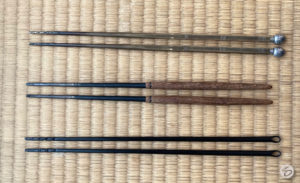
Many pairs of hibashi, or rather other types of hashi, 箸, sticks, had holes at the ends to secure a chain, kusari, 鎖, of string, to keep them together. Rikyū’s hibashi with the holes for example, may have once had a chain, or at least gives that inference to show that they are a pair, a single thing. Although hashi may be made of almost any material, but as the Kanji hashi, 箸, is composed of take, 竹, bamboo, and mono, 者, thing, hashi are most often made of bamboo.
Hashi are manipulated with the right hand, holding the two sticks so that they can hold something. One of the sticks is held between where the thumb joins the palm and between the middle and ring fingertips, and remains stationary. The other stick is held like a pen, and performs the action. The action is like a pivot, opening and closing the ends. The sticks form the Kanji for eight, hachi, 八, which is called sue-hiro, 末広, ends-wide, the symbol of Infinity in Space. In the act of opening and closing the hashi, the Kanji 八 has the fulcrum at one end, and then at the other end. This creates two Kanji for eight, which can be written with the Kanji 八八. This number can be interpreted as eighty-eight, which is symbolic of the center of infinity in each direction.
In traditional Japanese craft, measurements are determined using the shaku, 尺, span, which originated in the span of the human hand between the thumb and forefinger. In former times, the length of the shaku varied until two lengths were established, the kane-jaku and the kujira-jaku. The kane–jaku, 曲尺, bend-span, which is equivalent to a standard foot of twelve inches, and the kujira-jaku, 鯨尺, whale-span, which is the equivalent to 14 7/8 inches. Certain artists and craftsmen use either shaku in their work. To avoid possible confusion, in modern times measurements are usually given in centimeters. A shaku is divided into ten sun, 寸, which is divided into ten bu, 分, which is divided into ten rin, 厘.
The standard length of the hibashi is 9.5 sun kane-jaku, 寸曲尺, sun-bend-shaku, or 28.5 cm. The number 95 in Japanese can be read kyū-go. Another meaning of kyū-go, 救護, is salvation-guard, relief. Could this be the intention of the numerical significance of the hibashi and kan? The full length of the hibashi including the finial using the kujira-jaku is 7.7 sun kujira-jaku. Kazari hibashi are often of square section at the handle end, so that they do not roll. The length of the squared section including the finial is 4.4 sun kane-jaku; the length of the rounded end from where the squared section ends is 4.4 sun kujira-jaku. The ends relate to each other 8:10 or 4:5. The number 4 is In, negative – square is Yō; 5 is Yō, positive – round is In.
Hibashi indentations: kazari hibashi: 4 on front and back, 5 on the sides. Ro: L. 9.3 sun kane-jaku [9.5 sun kane-jaku is ideal]; handle L. 4.7 sun kane-jaku [5 sun kane-jaku is ideal], metal end L. 4.5 sun kane-jaku; indentations alternating 3 and 4 on four sides. Furo: alternating 4 indentations on four sides, in an area of 12 bu kane-jaku.
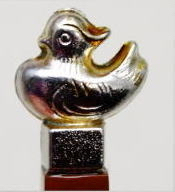
The handle end of the kazari hibashi may have a decorative knob or finial called an atama and kashira, 頭, head. The finial may be in the design of various objects, geometric or natural. Tori-gashira, 鳥頭, bird-head, which also means forgetful, similar to the western ‘bird-brain’. The birds are mandarin ducks, oshidori, 鴛鴦, male mandarin duck-female mandarin duck, which, like many birds mate for life. The mandarin ducks are emblems of marital happiness. As they are aquatic birds, they are emblematic of water to protect against fire. Ducks also live on fresh water bodies, ponds, lakes, etc. Because the birds have a shō-men, 正面, true-face, it is necessary to maintain the heads of the birds facing forward. Although mandarin ducks are water birds, they nest in holes in trees, high above the water. They prefer dense, shrubby forested edges of rivers and lakes. In winter, they occupy marshes, flooded fields, and open rivers, as well as in coastal lagoons and estuaries.
The leaf of the gingko resembles a duck’s webbed foot; ahiro no mizu kaki no katachi, 鶩の水搔きの形, duck water-paddle [webbed foot] shape. This is source of numerous mizu-tsugi, 水次, water-next, pitchers with designs of gingko leaves, and a significant reference to water and the duck finial hibashi.
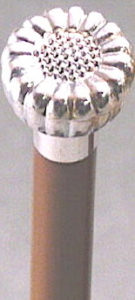
Another popular motif for the finial is the kiku-gashira, 菊頭, chrysanthemum-head. The word kiku sounds like the word kiku, 聞く, listen, which may refer to the sound of matsu-kaze, 松風, pine-wind, made by water simmering in the kettle, and one ‘listens to’ rather than smells the fragrance of incense. The chrysanthemum is an emblem of Infinity in Space, as its petals radiate in all directions – specifically 16 and 32 petals, and so is an emblem of the omnipresence of the emperor. The chrysanthemum has a close connection with water: kiku-sui, 菊水, chrysanthemum-water, which refers to the belief that drinking the morning dew from the petals of a chrysanthemum will impart immortality.
Pictured above is kazari hi-bashi, 飾火箸, display fire-rods; kiku-gashira, 菊頭, chrysanthemum-head, silver alloy.
The shi-no-mi, 椎の実, mallet-’s seed, also used as a finial, is a kind of oak so that the seed is a kind of acorn. This wood is the medium for growing shii-take, 椎茸, oak-mushrooms. The connection with fire, is that the charcoal used to build the fire for making tea is a kind of oak called kunugi, 椚, Quercus acutissima.
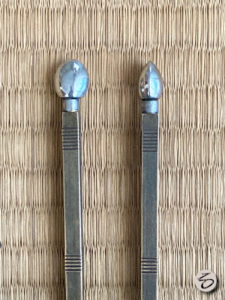
The gin-nan, 銀杏, silver-apricot, the gingko nut, is an emblem of Urasenke because of its connection with Sōtan, Rikyū’s grandson. The Japanese name for the gingko is ichō, which can be written with the Kanji, 鴨脚樹, duck-foot-tree, because of the shape of its leaves. Although the gingko nut is rather unrelated to water, as its leaf is identified with a duck, it alludes to water, for protection against fire. Curiously, during the destructive fire in Kyōto in 1788, a gingko tree next to Sōtan’s Tea hut, Yū-in, 又陰, Again-retire, rained down liquid onto the building helping to save it from the blaze that destroyed much of the area. The anniversary of Sōtan’s death is held on November, 19, when the ripe gingko nuts are gathered to serve at his memorial. Hōunsai’s konomi kazari hi-bashi are the Shichi-go-san, 七五三, 7 5 3, which alludes to the Shintō ritual that honors children of those ages, held on November, 15. The gingko seed is surely to symbolize the beginnings of activities and new life.
The gingko nut finial is made of a silver alloy, nan-ryō, 南鐐, south-‘silver’. The ginnan finial is composed of the rounded, slightly pointed oval and a stem the measures 5 bu kujira-jaku. The nut is 4 bu long, the stem 1 bu. The nut relates to the full length of the stem and nut, 4 to 5.
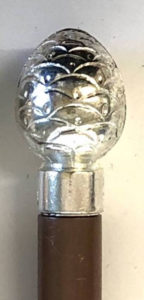
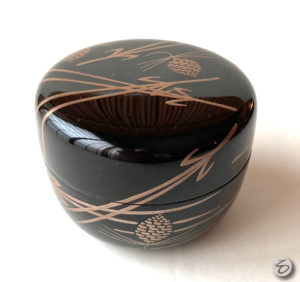
A finial selected by Rikyū is the matsu–kasa, 松笠, pine-cone, which would suggest a connection with matsu-kaze, 松風, pine-wind. The sound of ‘pine wind’ indicates that the water is at the right temperature for making ma-tcha, 抹茶, powder-tea. Handling the pair of hibashi causes them to resemble a two-tine pine needle, which is emblematic of Infinity in Space. The tea container has designs of pine needles and pine cones, that evokes beginnings and endings. Pine cones hold seeds of life, and fallen pine needles are a classic symbol of mortality.
When the hibashi are taken from the shakutate, they are temporarily in the area identified by the trigram for Wind, Son. Perhaps a little far-fetched, but the hibashi with pine needles and pine cones could evoke matsukaze. Since ancient times, the Japanese feel that the sound of matsukaze is filled with melancholy and longing. The word matsu, 松, for pine sounds like the word matsu, 待, for wait. Perhaps just coincidence, but Rikyū’s tea hut is named Tai-an, 待庵, Wait-hut.
Rikyū also chose as a finial the chō-ro-gi, 長呂木, long-spine-tree, called Japanese artichoke, with the Latin name, Stachys affinis. Used in Japan as a medicine for respiratory issues, its tubers, often pickled and dyed red, are common fare at meals. Its association with hibashi is, as yet, unclear. The form of the tuber on the hibashi resembles a three-lobe bottle gourd, which may be its actual source. The bottle gourd, hyō-tan, 瓢箪, gourd-basket, may be represented throughout many Tea utensils. The bottle gourd is a sacred symbol in Taoism.
In Chanoyu, utensils are usually handled with the right hand, however, ideally, both hands should be used to handle each object, which shows a fullness of involvement. The hibashi are used primarily with the right hand, but there are times when both are used.
When removing the hibashi from the shakutate, both hands are put on the tatami for support, as the hibashi are rather far away. The right hand takes the pair of hibashi lifts them out toward the back right of the shakutate, lowers them along that side, brings them forward. When moving them from the daisu, they are turned to be parallel with the host’s knee line, with the points toward the left direction. The left hand holds the middle of the hibashi, as the right turns the rods so that the points are toward the daisu, reholds with the left from above, and with the left-hand places the hibashi on the floor half-way along the side the jiita. With the left, the hibashi are slid back until only the finial of the hibashi remain outside. The right hand is continuously on the tatami as this action takes place. Once the hibashi are moved, both hands are placed together on the tatami. This location is identified with the trigram for Fire, Ri, 離, which means detach, separation, disjoin, digress, etc. At the beginning of the most formal Tea presentation, the hibashi are removed from the shakutate one by one, but still handled in the same manner. After each is put on the floor half-way back, the pair are slid further back until only the finial is projecting outward. In sacred offerings of Tea, the hibashi are placed on the jiita of the daisu to the left of the furo.
Intrinsic to calligraphy are the three styles of shin, 真, true, gyō, 行, transition, sō, 草, grass. These three aspects are found in many, many objects and circumstances. The three styles of chashaku are a good example. Perhaps these three modes can be seen with the hibashi. When the hibashi are displayed upright in the shakutate, they might be regarded as shin, manifesting possibilities. When resting horizontally on the floor, might be regarded as sō, inaction. When in use, transferring charcoal, they might be seen as gyō, moving, active, transitioning, enacting function.
When a large piece of charcoal is to be moved, the left hand may help by squeezing the rods together. When changing the hold on the hibashi, the points are placed on the tatami in front of the right knee. But when handling the kazari hibashi, the left-hand aids in re-holding them rather than changing the grip on the hibashi by touching the points on the floor, as with other types of hibashi. This is a bit curious, because the kazari hibashi are laid on the floor. When finished with their use, the hibashi are held over the sumi-tori, and swept with the habōki. In these subtle ways, the hibashi are handled with both hands.
The initial building of the charcoal fire is called shō-zumi te-mae, 初炭手前, first-charcoal hand-fore, and re-building the charcoal fire is go-zumi te-mae, 後炭手前, latter-charcoal hand-fore. Specifics and sequences of the charcoal presentations differ between the furo and the ro.
Before the presentation of building the charcoal fire in the presence of the guests, burning charcoal is put into hearth, which is called a shita-bi, 下火, down-fire, base fire. Special utensils are used, and are identified as mizu-ya dō-gu, 水屋道具, water-house way-tool. These tools include mizuya hibashi, 水屋火箸, fire-rods, also called naga hi-bashi, 長火箸, long fire-rods, with different sizes for furo and ro, and mizu-ya kan, 水屋鐶, metal rings.

Using the hibashi to put charcoal into the burning charcoal base fire is feeding the fire. There is a Japanese thought that picking up food to put into mouth with hashi in your hand was like a crane feeding its young. The crane, tsuru, 鶴, is a bird that the Japanese believe that it may live for a thousand years; tsuru sen-nen kame man-nen, 鶴千年亀万年, crane thousand-years tortoise ten thousand-years. These two emblems of longevity are paired symbols of good fortune and marital happiness. A tortoise or turtle, 亀, and a snake, hebi, 蛇, are identified as a symbol of the northern quadrant of the heavens, and called Gen-bu, 玄武, Black-warrior. This sign is also identified with Bi-sha-mon-ten, 毘沙門天, Help-sand-gate-heaven, who guards the north and the Buddha, and the leader of the Shi-ten-nō, 四天王, Four-heaven-kings, among whom is called Ta-mon-ten, 多聞天, Multi-hear-heaven. The black furo may, for some, resemble a black tortoise. Why is the preferred furo, the mayu bu-ro, 眉風炉, eyebrow wind-hearth, which is black ceramic? And, what is the significance of the hi-mado, 火窓, fire-window, that is ovoid-shaped and called a mayu, 眉, eyebrow?
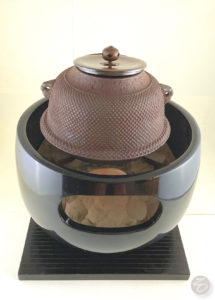
There is a Kanji that is read mayuzumi, 黛, meaning blackened eyebrow, that is also written with the Kanji that are more descriptive; mayu, 眉 eyebrow, and sumi, 墨, charcoal. The Kanji 黛 is composed of kuro, 代, black, and shiro, 代, substitute, which reads like white. Black and white? In Japan, eyebrows were often plucked or shaved off, and ‘brows’ were cosmetically applied charcoal dust above the line of the natural eyebrow that was a smudge the resembled the cocoon of a silk worm which is also read mayu, 繭. The himado of the mayu buro, is in the shape of the mayu cocoon.
There is a theory that the charcoal and a binding agent when applied to the forehead, was an aspect of Chinese medicine for headaches. In grief, some people rub their forehead just above the eyebrows. In Asian acupressure, the area on the forehead directly above the eye and brow is a point called Yō-Haku, 陽白, Yang-White. This is quite provocative, as the cosmetic eyebrow is black on an area called white. The himado is an opening in the front wall of the furo, which reveals the light-colored ash within the furo. The structure of the furo is based on the function of the opening in the front of the bowl through which wood or charcoal would be put to feed the fire within, but this is not the custom in Chanoyu.
It is said that black, eye cosmetic called kone-boku, 捏墨, knead-ink, was made by blending tsuyu–kusa, 露草, dew-grass, Asiatic dayflower, beni, 紅, red, and yu-en, 油煙, oil-smoke, and adding go-ma abura, 胡麻油, foreign-hemp oil, sesame-oil and kneading it. Mixing it with kin-paku, 金箔, gold-foil [leaf], and ash made from shiro yanagi, 白柳, white willow, Salix alba. Rouge, powder cosmetic created more than three thousand years ago in China was made from the extracted juice of leaves from red and blue flowers.
Tsuyu-kusa, Commelina communis, a seemingly insignificant ‘weed’ with a cute little flower has been used widely in medicine in Asia since ancient times. Sesame seeds are regarded as the highest in Yang aspect of the vegetables, which are classified as Yin. The seeds and oil have been eaten and used widely in Asia, for their benefits to health.
The inner bark of the willow contains salicin, as found in aspirin, and has been an effective medicine for millennia throughout the world. From the fifth century BC Chinese women used the soot derived from burning willow branches to paint their eyebrows, which continued into the Tang period, when arched and thin eyebrows, resembling a willow leaf or a moon as symbols of elegance. The ancient Greeks tied willow branches around the head to get rid of headache. It appears that willow ash in the eyebrow makeup may have been a beneficial medication. From ancient times, the Japanese also blackened their teeth with o-ha-guro, お歯黒, hon.-tooth-black

Essential sumi dō-gu, 炭道具, charcoal way-tools, include a pair of kan, 鐶, metal rings, that are used to move the kama, 釜, kettle. The kan are made of various metals including the common hagane, 鋼, steel, or tetsu, 鉄, iron. Standard kan are made of slender metal round rods often with tapered ends so that they can be slipped in and out of the lugs on the kama called kan-tsuki, 鐶付, metal ring-attach. There are many styles of metal rings including shapes other than round. The standard form of a kan is an over-lapping circle with points separated so that they can be slipped into the lugs of the kettle. The over-lapping measurement between the ends of the kan rod is 8 bu kane-jaku, or 2.5 cm.
The standard kan may be identified with the rings that are used by the host, are generally outside the view of the guests, and these are called mizu-ya kan, 水屋鐶, water-room metal rings. These are usually made of brass, shin–chū, 真鍮, true-brass. The outside diameter of the ring is generally 2.8 sun kane-jaku. The space between the inside of the over-lapping ends is .4 sun kane-jaku. Were the metal ring to be un-curled and straightened out, the length of the metal rod is 9.5 sun kane-jaku. This is the same length as the standard hibashi. The pairs of kan and hibashi are examples of In and Yō: round is In, and long, straight in Yō.
In a simple charcoal presentation, some of the utensils are placed in or on a sumi-tori, 炭斗, charcoal-measure, which can be a basket, box or gourd, etc. The character, 斗, has numerous meanings including use for the constellation of the Big Dipper. The word ‘tori’ implies carry or take up. The word ‘measure’ is close to its meaning as the number of pieces of charcoal is prescribed according to the type of presentation.
Again, in a simple and familiar charcoal presentation, the utensils placed in or on the sumi-tori, include a pair of hibashi which have the handles extending over the front edge of the container. A pair of kan are hung over the ends of the hibashi with the points at the bottom. This simple and seemingly arbitrary procedure can exist with little acknowledgement of a more profound association with symbolic significance.
Comparing the pair of hibashi and the pair of kan, the hibashi are straight, which manifests the Yang/Yō principle, and the kan are circles which manifest the Yin/In principle. Hibashi handle fire, Yang/Yō, and the kan assist in handling water, Yin/In, in the kama. Carried in the sumitori, the hibashi are laid nearly flat in the sumitori, which is Yin/In, while the kan are hanging vertically which is Yang/Yō. At the start of the charcoal presentation, the hibashi are taken out from the right side of the shakutate but are moved to the left side, the side of the fire in the furo.
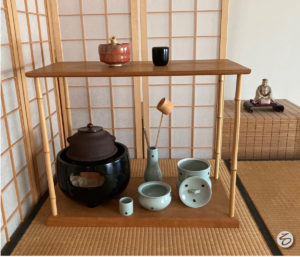
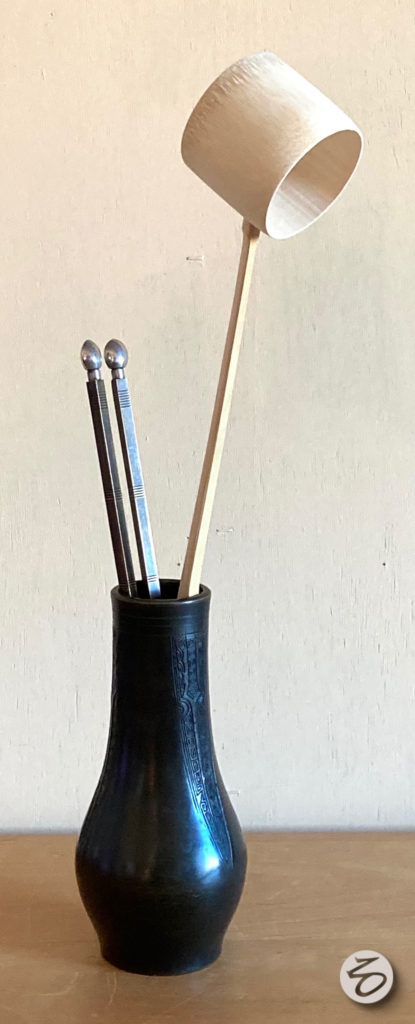
The hishaku is correctly placed in front of the hibashi, leaning forward toward the front, and the hibashi behind leaning toward the back. The hishaku handles water, the hibashi handle fire. According to the Ekikyō, Water is identified with the north, and Fire is identified with the south. By their identification and location, the arrangement metaphorically places the teishu in the north. This is enhanced when the teishu holds the hishaku in the gesture called kagami bi-shaku, 鏡柄杓, mirror handle-ladle. With the mirror ladle handling which places the teishu in the north, the teishu is acting on behalf of deity, who is ideologically located in the north.
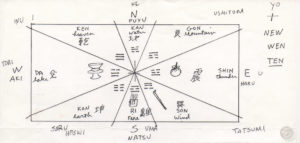
Chanoyu has many elements that have their symbolic significance associated with I Ching, Japanese, Eki-kyō, 易経, Change-sutra. Each tea utensil is identified with one or more of the ha-kke, 八卦, eight-divination signs, called in English trigrams, as each sign is composed of three lines. The ‘old arrangement’ of the trigrams is identified with the ji-ita, 地板, earth-board, of the daisu. The upper shelf of the daisu is called the ten-ita, 天板, heaven-board, and is identified with the ‘new arrangement’ of the eight trigrams. It is important to know that the front or shōmen of the jiita is identified with the north, and that south is at the back. This also locates the teishu in the north. The tenita is just the opposite.
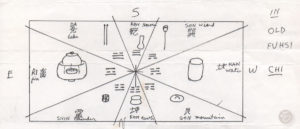
The eight trigrams of the Eki-kyō are placed on a large tray in the form of inlaid ao-gai, 青貝, blue-shell, which gives the tray its name hakke bon, 八卦盆, eight-sign tray. The diameter of the round, black-lacquered tray is 8.8 sun kujira-jaku. The hakke bon is the prime feature of the formal Tea presentation of Gyō-no-gyō Tenmae, 行之行台子点前, Transition-’s-transition Support-of Presentation. The front or shōmen of the tenita is identified with the south, and opposite to that is the north the location of deity.
The very first thing that the teishu does is to move the hakke bon to the front the center of the tenita closer to the front edge of the tenita. This has always been a curious action. However, it does show that the teishu has control of the hakke, the eight trigrams of the Eki-kyō, 易経, Change-sutra. It should be remembered that Sen no Rikyū’s name was Sō-eki, 宗易, Sect-change, and change implies movement. The teishu is in control of the hakke and the Ekikyō. The Kanji, eki, 易, is composed of nichi, 日, sun, and getsu, 月, moon. The sun and the moon are prime examples of Yō and In, the positive and negative aspects of the Ekikyō. The sun in Japanese is called Tai-Yō, 太陽, Great-Yang, and the moon Tai-In, 太陰, Great-Yin.
The next action of the teishu is to take the hibashi from the shakutate, and lay them next to the jiita of the daisu. Although the teishu does not actually use them, handling the hibashi shows that the teishu has power over fire. The same is true of the teishu handling the hishaku, which shows power over water.
The shakutate is placed on the trigram ☰ for Heaven, Ken, 乾. The hishaku and the hibashi are held in the shakutate, and when take out, they become identified with adjoining trigrams. The hishaku is identified with the trigram ☴ for Son, 風, Wind, on the right which is toward Water and the mizu-sashi, 水指, water-indicate, filled with water. Hibashi are taken from the shakutate on the right side, but are moved to the left side of the shakutate, which is toward Fire and the fire in the furo. The trigram ☱ to the left of the shakutate is named Da, 兌, open, exchange, etc., and represents sawa, 沢, or 澤, swamp, lake, valley irrigated field, and means joyous, With their associations with water, it may be that the hibashi are imbued with the essence of water acting as protection from fire.
Before investigating the symbolic significance of the charcoal presentation, an examination of other utensils used in the charcoal presentation may contribute some help to understanding. There are standards which apply to various utensils, often attributed to objects associated with Sen no Rikyū. A standard sumitori for use with the furo, is a bamboo basket that is 8 sun kane-jaku square. Eight is the prime number of Infinity in Space.
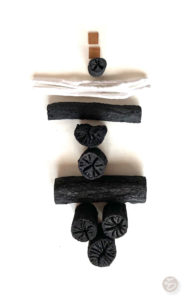
Sumi, 炭, charcoal :from the top:
Two byaku-dan, 白檀, white-sandalwood.
Ten-zumi, 点炭, offer-charcoal.
Two eda-zumi, 枝炭, branch-charcoal.
Kuda-zumi, 管炭, tube-charcoal.
Wari-gitchō, 割毬打, divided- charcoal.
Gi-tchō, 丸毬打, ball-hit.
Dō-zumi, 胴炭, body-charcoal.
Three gitchō, 毬打, ball-hit; shita-bi, 下火, down-fire.
Charcoal, sumi, 炭, pieces are cut to specific lengths, 2 and 4 sun. Furo charcoal is measured with kane–jaku, 曲尺, bend-measure, and ro charcoal is measured with kujira-jaku, 鯨尺, whale-measure. The word ‘whale’ is derived from the use of whale baleen as a measuring device, similar to a tape measure, as it can wrap around curves. Charcoal for the furo and the ro have the same measurements, but are measured with different length shaku.
The most common size of the charcoal piece is the 2 sun maru git-chō. 丸毬打, round ball-hit. This has its origins in the mallet head of a croquet like game. The number of pieces of charcoal placed in the furo, consists of three gitchō of burning gitchō as a shita–bi, 下火, down-fire, with a total of 6 sun. To these are added five specific pieces, totaling eight pieces.
The five pieces of charcoal in order when placed in the furo are:
dō zumi, 胴炭, body charcoal 4 sun.
maru gitchō, 丸毬打, round gitchō 2 sun.
wari gitchō, 割毬打, divided gitchō 2 sun.
kuda zumi, 管炭, tube charcoal 4 sun.
ten zumi, 点炭, point charcoal 2 sun.
total 14 sun.
plus 3 gitchō shitabi 6 sun.
total 20 sun.
These charcoal pieces may have symbolic associations, as there are five pieces which are different and placed in the furo with a particular order. They may be identified with the Go-rin, 五輪, Five-rings, or the five principles of Do, 土, Earth — Sui, 水, Water — Ka, 火, Fire — Fū, 風, Wind — Kū, 空, Void.
The word dō for body of the dō–zumi charcoal may be likened to the principle of Do, Earth. The dōzumi is the foundation of the charcoal pieces as is the principle of Earth. The symbolic representation of Earth is a cube or its approximation, while the dōzumi is the only piece laid on its side and appearing four sided. The round gitchō may be likened to the round or spherical form of the symbolic sphere of the principle of Water. The wari-gitchō is a half-moon shape that may suggest the triangle of the Fire principle. The tubular kuda-zumi may suggest the principle of Wind as it alludes to a hollow tube. The true form of the character for ten, 點, is composed of a combination of all Five Principles. It may suggest the complete un-dividedness of the Void, which is symbolic of undifferentiated In and Yō. The number of larger pieces of charcoal for the ro add one gitchō and a wari kudazumi.
The length of the hibashi is 9.5 sun kane-jaku. The numbers 9 and 5 are identified with the magic square, which is divided into nine squares in which a number from 1 to 9 is located. According to the Ekikyō, 5 is in the center, with pairs of numbers placed on opposite sides of the center total 15. Odd numbers are positive and even numbers are negative. The number 9 is placed in the middle above 5, and its opposite is 1. Added together total 15. The locations of 9 and 5 are symbolic of the Emperor, so that number 95 is emblematic of the Emperor. This has been established in ancient China and Japan to the present.
In simple sumi demae, the hibashi are placed in the sumitori with the points touching the floor of the container and the handle ends resting on the front rim of the container. The pair of kan are hung on the projecting handle ends of the hibashi with their points at the bottom. Uniting these four objects unifies them symbolically as well as physically. Having the same lengths and representing In and Yō adds to the symbolism. In old drawings of daisu arrangements of utensils, the kan and hibashi may be displayed together, touching on the tenita when there is no shakutate displayed on the jiita.
In the presentation of Gyō no gyō Daisu, 行之行台子, Transition’s-transition support-of, the front edge of the jiita is 9.5 sun kane–jaku from the host’s knee line, which is the length of the Rikyū furo hibashi. The gyō daisu itself is more familiarly called take dai-su, 竹台子, bamboo support-of, because it has four bamboo posts supporting the top shelf. In addition, with the take daisu used in conjunction with the ro, and on Chū Kyō tatami, the center of the mizusashi is located 95 sun kane from the outer edge of the tatami to the right; the same is for the center of the kensui and the shakutate from the left side of the tatami. The hibashi can be used to place the utensils in their correction locations. Because the size of the finial may vary, the shaft of 9 sun kane-jaku can be used to take measurements.

According to the Ekikyō, the kazari hibashi are identified with the trigram Da for Lake. The Kanji means open, exchange, and is composed of the Kanji for eight, hachi, 八, and elder brother, ani, 兄. Additional meanings include serenity, joy, tranquil, complete devotion, open, loosen, weigh, permeate speak.
Putting the two hibashi placed end to end, resembles, somewhat, the do-kko-shō, 独鈷杵, single-cobalt-pestle. This weapon is more familiarly known as a vajra. The simplest vajra is a single rod pointed at both ends, and often in square section, called sei-hō-kei dan-men, 正方形断面, correct-side-shape resolution-face.
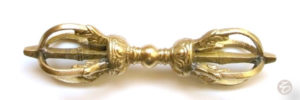
The vajra has many different forms and is composed of various elements. The center is a globe or sphere with an eight-petal lotus on each side, supporting two or more sea creatures called makara with long pointed tongues. The lotus and the makara are associated with water. The water association provides a metaphorical protection against fire. The lotus plant grows only in fresh water with muddy floors. Such bodies of water include lakes. Is this connection enough for the hibashi, which are identified with the trigram for Lake, Da, for the symbolic protection against fire?
The vajra is held by Tai-shaku-ten, 帝釈天, Emperor-explain-heaven, Indra, the king of the gods. Not only was he the mightiest of gods, but also the god of storms, thunder, and war. The dokkoshō represents the lightning bolt that he wields, holding it in his right hand. Taishakuten lives on the peak of Shu-mi-sen, 須弥山, Necessarily-increase-mountain, the center of the Hindu and Buddhist world. He is the leader of the Shi-ten-nō, 四天王, Four-heaven-kings, who guard the four directions. Shumisen is the model for the altar called Shu-mi-dan, 須弥壇, Necessarily-increase-altar, which is often used in the worship of A-mi-da, 阿弥陀, Praise-increase-steep, the Buddha of Compassion, who is in his western paradise of Jō-do, 浄土, Pure-land.
Taishakuten, also called Sakra, rides the great white elephant named Airavata, that was created in the Churning of the Milk Ocean, and is identified with its watery foam. Airavata was, in part, responsible for the conception of the Buddha, and was present at important moments throughout Buddha’s life. While riding Airavata, Indra, with his lightning bolt removed the veil of Vritra with which he concealed the world.
Taishakuten, Indra, and the other gods are always in conflict with the A-shu-ra, 阿修羅, Praise-discipline-spread, originally Hindu demi-gods. The leader of the Ashura is called Tai-yō-shin, 太陽神, Great-yang-god, the Sun God, or the god of fire, and who always loses in the battle with Taishakuten. Indra is often presented as the twin brother of Agni, A-gi-ni, 阿耆尼, Praise-aged-nun, the Hindu god of fire.
In an ancient Vedic hymn, Indra is lauded for his heroism: with his vajra he killed Vritra, the serpent, let flow the waters that gushed out, forming seven rivers that went to the Ocean, Samudra, Gathered-waters. These affiliations may suggest a connection between Taishakuten and the hibashi, and control of the charcoal fire.
While presenting the charcoal fire in the presence of the guests, the teishu, with the hibashi, handles fire only once when moving the front piece of the shitabi to the back of the other two pieces of burning charcoal. This movement changes the direction of everything, primarily, the teishu’s location from south to north. It is interesting to note that these changes are made through the aspect of fire.
The churning of the milk ocean was part of the gods’ creation of soma, the elixir of immortality. Indra is closely identified with soma, in which he over-indulged. Although it is not known the source of soma, it is thought that is from the juice of the stems of ephedra. Tea is often thought of as a kind of soma.
After killing Vritra, Indra hid in Manasarovar, Invincible Lake, in which was the means of purification, to escape punishment for the sin of a Brahmin. Lake Manasarovar is at the foot of Mount Kailash in Tibet, which is believed to be the earthly Mount Sumeru, which in Japanese is Shumisen.
The Lake, alluded to in the trigram, is associated with the dragon, especially in Zen Buddhism, and with the kundalini, the Hindu concept of the maturation of the nervous system. The track of kundalini begins in the bottom of the left big toe, proceeds up the leg to the backbone, where it is depicted as a koi fish swimming up a waterfall. It is believed that if the fish enters the pool above the waterfall it is transformed into a dragon. The dragon is the symbol of enlightenment, satori, 悟り, the pool or marsh is depicted as clouds where resemble the human brain. This image is called, un-ryū, 雲龍, cloud-dragon, and is a popular design motif, such as Rikyū’s un-ryū gama, 雲龍釜, cloud-dragon kettle. In depictions, often on the ceilings of Zen temples, lightning bolts are emblematic of the concept of enlightenment. In formal Tea presentations, the ash bed of the furo is covered with uroko-bai, 鱗灰, scale-ash, which evokes the scales of a dragon that are likened to those of the koi, 鯉, carp.
In Asian beliefs, of the many dragons four are identified with the directions and one in the center, and these are also identified by different colors. The dragon of the north is black, koku-ryū, 黑龍, black-dragon, and is also called gen-ryū, 玄龍, black-dragon. The more familiar creature identified with the north is Gen-bu, 玄武, black-warrior, or black tortoise-snake. The black dragon may be evoked by a black furo. The ash bed within the furo, for formal Tea presentations, is formed into uroko-bai, 鱗灰, scale-ash, suggesting dragon scales, which are likened to the scales of the koi.
In the Chinese system of Fengshui, in Japanese Fū-sui, 風水, Wind-water, the figure of a lucky dragon is placed in the gen-kan, 玄関, black-barrier, foyer, entrance hall. It is important to place a cup of water in front of its mouth, and to refresh the water every day. From the perspective of the shō-kyaku, 正客, main-guest, when the furo is present, the mizusashi is placed in front of the kama: the lug of the kama is often in the form of a dragon head. The water in the mizusashi is an offering in front of the dragon mouth. The open lug is the open mouth of the dragon.
The seat of the shōkyaku in a yo-jō-han, 四畳半, four-mat-half, is in front of the tokonoma, facing the Tea utensils. The shōkyaku has his or her back to the east, with the tokonoma on the right. The back wall of the tokonoma is identified with the east.
The furo with the trigram Kan, 坎, for Water establishes the north direction, and the shōkyaku to the right is metaphorically located in the south. With the mizusashi to the right of the furo, the water is identified with the north, and the fire is identified with the south, so that the water/north places the shōkyaku in the north. In the tokonoma on the right of the shōkyaku is a hanging scroll and flowers in a water container. Water on the right locates the shōkyaku in the south. The Japanese word for south is minami, 南, which is said to have its origins in ‘all the people, mina, 皆, all, mi, 見, look. The people in the south look north toward deity.
For the ceremonies of Obon, お盆, hon.-tray, small fires are built using sticks called o-gara, 麻幹, hemp-stalks, L. 6 sun kane-jaku. They are burned on a hō-roku, 焙烙, fire-burn, a wide, shallow, ceramic bowl. The fire is transferred to a lantern that is set adrift on a river to float to heaven joining spirits in the Milky Way. The stalks are made especially for Obon, and are sold at various markets, and come in lengths as long as 3 shaku kane-jaku, about three feet. The size for burning is 6 sun kane–jaku. Three 3 shaku kane-jaku long stalks are cut into five pieces that are 6 sun kane-jaku long, which results in fifteen stalks. Transferring the fire from the hōroku to the lantern is in the form of a candle which is put into the lamp.
One might wonder what connection there is between the obon fire and the charcoal fire of Chanoyu. Together with the charcoal that make the fire to heat water are several pieces of edazumi. For furo, the edazumi are 5 sun kane-jaku long and two pieces are added to the fire. For the ro the edazumi are 4.8 – 5 sun kujira-jaku long, and four pieces of edazumi are added to the fire. The edazumi resemble in form to the ogara sticks.
